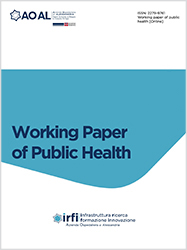The role of the physiotherapist in pediatric obesity prevention: comparing experiences.

Accepted: 27 January 2022
All claims expressed in this article are solely those of the authors and do not necessarily represent those of their affiliated organizations, or those of the publisher, the editors and the reviewers. Any product that may be evaluated in this article or claim that may be made by its manufacturer is not guaranteed or endorsed by the publisher.
Background. Obesity is an emerging issue with serious health consequences. It is preventable in pediatric settings through prevention projects and education about healthy lifestyles. The aim of the study is to analyze the problem and the methods of intervention, through the involvement of physiotherapists throughout Italy, and to explore the interest and sensitivity of Italian physiotherapists to the issue.
Study design. A cross-sectional survey of physiotherapists was conducted using a self-completed online questionnaire, from January to March 2020.
Materials and Methods. Literature analysis searching for national and international prevention strategies. Administration of a cognitive questionnaire to the pediatric GIS group.
Results. Ninety-five point seven percent of the interviewees had never taken part in projects dedicated to pediatric obesity. Three experiences emerged, but only two respondents made themselves available for interview. Ninety-four point four percent of the operators considered the contribution to the health problem useful and 82.2% of them expressed a real interest in the topic.
Conclusions. Physiotherapists should play an active role in planning interventions aimed at promoting and supporting healthy lifestyles from early childhood to early adulthood, starting even earlier during the prenatal and perinatal periods.
World Health Organization (WHO). Obesity and overweight, 26/11/2020. Available at: https://www.who.int/en/news-room/fact-sheets/detail/obesity-and-overweight [Last accessed: 2021 October 28th].
You L, Sadler G, Majumdar S, et al. Physiotherapists’ perceptions of their role in the rehabilitation management of individuals with obesity. Physiother Can. 2012;64:168-75. DOI: https://doi.org/10.3138/ptc.2011-01
Nicolucci, P. Sbraccia, R. Guerra, et al. Health Policy in non-communicable disease. Il burden of disease dell’obesità in Italia. Roma: IBDO Foundation, 2015. Available at: https://cupdf.com/document/il-burden-of-disease-dellobesita-in-italia-il-burden-of-disease-dellobesita.html [Last accessed: 2021 October 28th].
Morales Camacho WJ, Molina Diaz JM, Plata Ortiz S, et al. Childhood obesity: Aetiology, comorbidities, and treatment. Diabetes Metab Res Rev. 2019;35:e3203. DOI: https://doi.org/10.1002/dmrr.3203
Kumar S, Kelly AS. Review of Childhood Obesity: From Epidemiology, Etiology, and Comorbidities to Clinical Assessment and Treatment. Mayo Clin Proc. 2017;92:251-65. DOI: https://doi.org/10.1016/j.mayocp.2016.09.017
Vanelli M, Brambilla P, Colarizi R. Allarme obesità, combattiamola in 10 mosse, Cento (FE): Editeam, 2014. Available at: https://www.sipps.it [Last accessed: 2021 October 28].
Baker JL, Michaelsen KF, Rasmussen KM, Sørensen TI. Maternal prepregnant body mass index, duration of breastfeeding, and timing of complementary food introduction are associated with infant weight gain. Am J Clin Nutr. 2004;80:1579-88. DOI: https://doi.org/10.1093/ajcn/80.6.1579
Rito AI, Buoncristiano M, Spinelli A, et al. Association between Characteristics at Birth, Breastfeeding and Obesity in 22 Countries: The WHO 8. European Childhood Obesity Surveillance Initiative - COSI 2015/2017. Obes Facts. 2019;12:226-43. DOI: https://doi.org/10.1159/000500425
Bortolus R, Breda J, Buoncristiano M, et al. Sistema di Sorveglianza sui determinanti di salute nella prima infanzia, Sintesi dei risultati. Roma: Istituto Superiore di Sanità, 2019. Available at: https://www.epicentro.iss.it [Last accessed: 2021 October 28].
Yanovski JA. Pediatric obesity. An introduction. Appetite. 2015;93:3-12. DOI: https://doi.org/10.1016/j.appet.2015.03.028
Di Cesare M, Sorić M, Bovet P, et al. The epidemiological burden of obesity in childhood: a worldwide epidemic requiring urgent action. BMC Med. 2019;17:212. DOI: https://doi.org/10.1186/s12916-019-1449-8
World Health Organization (WHO). Noncommunicable diseases: Childhood overweight and obesity. 19 October 2020. Available at: https://www.who.int/news-room/q-a-detail/noncommunicable-diseases-childhood-overweight-and-obesity [Last accessed: 2021 October 28].
Jeffreys M, McCarron P, Gunnell, et al. Body mass index in early and mid-adulthood, and subsequent mortality: a historical cohort study. Int J Obes Relat Metab Dis. 2003;27:1391-7. DOI: https://doi.org/10.1038/sj.ijo.0802414
Must A, Jacques PF, Dallal GE, et al. Long-term morbidity and mortality of overweight adolescents. A follow-up of the Harvard Growth Study of 1922 to 1935. New Engl J Med. 1992;327:1350-5. DOI: https://doi.org/10.1056/NEJM199211053271904
Inanç BB. Metabolic syndrome in school children. J Clin Res Pediatr Endocrinol. 2013;5:140-1. DOI: https://doi.org/10.4274/Jcrpe.819
World Health Organization (WHO). Regional Office for Europe. The challenge of obesity - quick statistics. Available at: https://www.euro.who.int/en/health-topics/noncommunicable-diseases/obesity/data-and-statistics [Last accessed: 2021 October 28].
Townsend N, Scriven A. Obesity. London: Churchill Livingstone (Elsevier), 2013 (The Public Health Mini-Guides Series). 530 pp.
EU Action Plan on Childhood Obesity 2014-2020. 24 February 2014 [updated 12 March and 28 July 2014]. Available at: https://ec.europa.eu/health//sites/health/files/nutrition_physical_activity/docs/childhoo dobesity_actionplan_2014_2020_en.pdf [Last accessed: 2021 October 28].
World Health Organization (WHO). Regional Office for Europe. WHO European Childhood Obesity Surveillance Initiative (COSI). Available at: https://www.euro.who.int/en/health-topics/disease-prevention/nutrition/activities/who-european-childhood-obesity-surveillance-initiative-cosi [Last accessed: 2021 October 28].
Istituto Superiore di Sanità (ISS). Obesità: Informazioni generali. Available at: https://www.epicentro.iss.it/obesita/ [Last accessed: 2021 October 28].
Ministero della Salute. Piano Nazionale della Prevenzione 2020-2025. Available at: http://www.salute.gov.it/imgs/C_17_pubblicazioni_2955_allegato.pdf [Last accessed: 2021 October 28].
Istituto Superiore di Sanità (ISS). Guadagnare Salute, 2018. Available at: https://www.epicentro.iss.it/guadagnare-salute/programma/ [Last accessed: 2021 October 28].
Ministero della Salute, Istituto Superiore di Sanità (ISS), Centro Nazionale per la Prevenzione e il Controllo delle Malattie (CCM), Ministero dell’Istruzione. Infografica risultati 2019 OKkio alla SALUTE. Available at: https://www.epicentro.iss.it/okkioallasalute/pdf2020/infografica-2019.pdf [Last accessed: 2021 October 28].
Bortolus R, Breda J, Buoncristiano M, et al. Sistema di Sorveglianza sui determinanti di salute nella prima infanzia, Sintesi dei risultati. Roma: Istituto Superiore di Sanità, 2019. Available at: https://www.epicentro.iss.it [Last accessed: 2021 October 28].
Faigenbaum AD, Lloyd RS, Sheehan D, Myer GD. The role of the pediatric exercise specialist in treating exercise deficit disorder in youth. Strength & Conditioning Journal. 2013;35:34–41. DOI: https://doi.org/10.1519/SSC.0b013e318285618c
Al-Khudairy L, Loveman E, Colquitt JL, et al. Diet, physical activity and behavioural interventions for the treatment of overweight or obese adolescents aged 12 to 17 years. Cochrane Database Syst Rev. 2017;6:CD012691. DOI: https://doi.org/10.1002/14651858.CD012691
World Health Organization (WHO). Global strategy on diet, physical activity and health, 2004. Available at: https://www.who.int/dietphysicalactivity/strategy/eb11344/strategy_english_web.pdf. Last accessed: 2021 December 18].
Australian Government National Health and National Research Council (NHMRC). Clinical practice guidelines for the management of overweight and obesity in adults, adolescents and children in Australia, 2013. Available at: https://www.nhmrc.gov.au/about-us/publications/clinical-practice-guidelines-management-overweight-and-obesity [Last accessed: 2021 December 18].
Milne N, Choy NL, Leong GM, et al. Child obesity service provision: a cross-sectional survey of physiotherapy practice trends and professional needs. Aust J Prim Health 2016;22:140-6. DOI: https://doi.org/10.1071/PY14101
Supporting Agencies
NonePAGEPress has chosen to apply the Creative Commons Attribution NonCommercial 4.0 International License (CC BY-NC 4.0) to all manuscripts to be published.

 https://doi.org/10.4081/wpph.2022.9478
https://doi.org/10.4081/wpph.2022.9478




